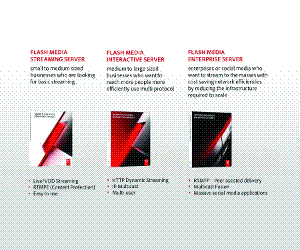First Look: Flash Media Server 4
 Remember those late-night infomercials where you're guaranteed to add bulk and muscle to your skinny frame? And if you buy now, they'll also throw in another supplement-free of charge-that guarantees you'll lose weight, regardless of what you eat?
Remember those late-night infomercials where you're guaranteed to add bulk and muscle to your skinny frame? And if you buy now, they'll also throw in another supplement-free of charge-that guarantees you'll lose weight, regardless of what you eat?
While those types of offers have been the butt of many jokes (and a few lawsuits), the premise has been enough to sustain these ads for years, even as technology has advanced: From their start in the classifieds section of magazines such as Popular Science to late-night television and, finally, into your email spam folder, the premise touches a near-universal desire to better ourselves, whether by gaining muscle, losing weight, or a combination of both.
Adobe is making a similar offer, although it's studiously avoiding late-night television. The offer goes something like this: Bulk up on our new flagship server, part of the Flash Media Server 4 family, at a hefty price upgrade, and we promise your media delivery budget will go on a bandwidth diet as soon as it's implemented.
Sound too good to be true? After a first look at the Flash Media Server 4 (FMS 4) family of servers, the offer appears valid.
But don't take our word for it: Stay tuned for a testimonial later in the article from a large technology company that put the FMS 4 premise to the test.
Building Blocks
Just like our late-night weight loss infomercial example, where more than just a diet supplement is needed to lose weight, FMS 4 works hand in hand with several key product rollouts that have become available over the past few months.
To allow for FMS 4's functionality such as Fast Switching and Fusion, which we'll highlight in the next section, Adobe needed to roll out upgrades across its entire ecosystem, from content protection and HTTP delivery to updated players.
Deciphering the timing of all these rollouts was a bit of a puzzle, as each product update seemed to need another product not yet ready for prime time.
For instance, Adobe could have launched Flash Media Streaming Server (FMSS 4), which supports RTMPE. But persistent encryption, used in Flash Media Interactive Server (FMIS) and Flash Media Enterprise Server (FMES) in conjunction with Flash Access, would have required additional tools.
"The move from session encryption with RTMPE to persistent encryption with Flash Access 2.0 is key," said Florion Pestoni, Adobe's principal product manager of rich media solutions, when Flash Access launched. "Many content owners may choose to download content to AIR-based rich internet applications for offline viewing. Since Flash Access 2.0 content will play back on Flash Player 10.1 and AIR 2.0, persistent encryption is an important step toward making offline players adhere to licensing and DRM concerns."
Flash Player 10.1 was still in beta at the time of Flash Access 2.0's launch, as was HTTP Dynamic Streaming (aka Project Zeri). Both finally launched in June, but HTTP Dynamic Streaming only supported on-demand content.
The advent of FMS 4, then, is meant to address all aspects of the ecosystem: HTTP Dynamic Streaming for live encoding, coupled with Fast Switching, and Stratus, Adobe's peer-assisted networking for its new Real-Time Media Flow Protocol (RTMFP) delivery protocol.
Support for Stratus is a key selling point for the flagship FMES version. While Stratus was renamed Fusion under FMS 4, the RTMFP protocol's inclusion in Flash Player 10.1 meant that Stratus would enable group or user segmenting, to send messages only between members of the group. This was an important element of FMS 4's implementation of Fusion, as application-level multicast "provides one (or a few) -to[o]-many streaming of continuous live video and audio live video chat using RTMFP groups."
The lag time between Flash Player 10.1's availability in mid-June and the October availability of FMS 4 was beneficial in one respect: The typical time for upgrading from one version of a Flash Player to the next can be measured in weeks, while a Flash Media Server can be set up in days; as such, the likely installed base of Flash Player 10.1 users capable of Fast Switching is higher now that it would have been under FMS 3.5.3.
The advent of FMS 4 means that Adobe has almost finalized the move to its new ecosystem, with H.264 hardware acceleration for Macs as the only ecosystem piece still in beta.